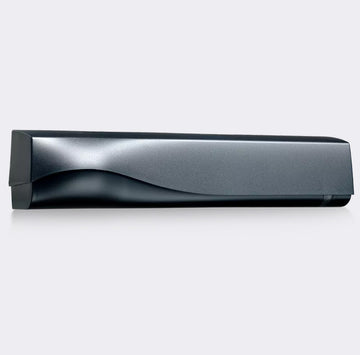
BEA IXIO-DT1 Dual-Tech Sensor – Sliding Door Activation & Safety
TABEL OF SPECIFICATIONS
| Detection Mode | |
|---|---|
| Motion | Minimum detection speed: 2 in/s |
| Presence | Typical response time: < 200 ms (max: 500 ms) |
| Technology | |
|---|---|
| Microwave Doppler Radar | Transmitter frequency: 24.150 GHz Transmitter radiated power: < 20 dBm ERP Transmitter power density: < 5 mW/cm² |
| Active Infrared with Background Analysis | Spot size: 2" × 2" (typical) Number of spots: max. 24 per curtain Number of curtains: 2 |
| Mounting Height | |
|---|---|
| 6'6" – 11'6" Local regulations may impact acceptable mounting height (pedestrian applications only) |
| Sensor Temperature Range | |
|---|---|
| -13 – 131 °F 0 – 95% relative humidity, non-condensing LCD screen is operational from 14 – 131 °F. The sensor may still be programmed in colder temperatures, but with the remote control. |
| Output | |
|---|---|
| Relay 1 | Electromechanical relay (potential and polarity free) Max. contact current: 1 A Max. contact voltage: 30 VAC Adjustable hold time: 0.5 – 9 s |
| Relay 2 | Solid-state relay (potential and polarity free) Max. contact current: 100 mA Max. contact voltage: 42 VDC / 30 VAC |
| Test/Monitoring Input | |
|---|---|
| Sensitivity | Low: < 1 V High: > 10 V (max. 30 V) |
| Response time on test request | Typical < 5 ms |
| Supply Voltage | |
|---|---|
| 12 – 24 VAC ±10% 12 – 30 VDC ±10% To be operated from SELV-compatible power supplies only |
| Power Consumption | |
|---|---|
| < 2.5 W |
| Noise | |
|---|---|
| < 70 dB |
| Degree of Protection | |
|---|---|
| IP54 |
| FCC Certification | |
|---|---|
| FCC | G9B-100606 |
| IC | 4680A-100606 |
| Compliance | |
|---|---|
| ISO 13849 PL «C» CAT. 2 (under the condition that the door control system monitors the sensor at least once per door cycle) |
-
-
Key Specifications
-
Product name: BEA IXIO-DT1 dual-technology sensor for automatic sliding doors; combines microwave activation with active infrared (IR) presence protection.
-
Detection architecture: K-band microwave Doppler for motion (activation) + two high-density active-infrared presence curtains.
-
Curtain resolution: Two IR curtains, up to 24 spots per curtain; typical spot size ≈ 2 × 2 in on the floor for precise threshold protection.
-
Microwave tuning: 10 sensitivity steps; receding-traffic immunity available to reduce false opens and save energy.
-
IR tuning: 3 immunity levels; adjustable curtain angle (approx. –7° to +4°), width/tilt/rotation; visible red spots assist live alignment.
-
Mounting height (pedestrian): 6’6″–11’6″ (≈ 2.0–3.5 m); verify with local codes.
-
Speed & response: Minimum motion detection ≈ 2 in/s; IR presence typical response <200 ms.
-
Electrical / I/O: 12–24 VAC ±10% or 12–30 VDC ±10% (SELV); <2.5 W typical; two outputs (1× electromechanical relay up to ~1 A / 30 VAC; 1× solid-state relay up to ~100 mA / 42 VDC); test/monitoring input (low <1 V / high >10 V) for controller supervision.
-
Environmental / housing: Operating –13 to 131 °F, LCD operable 14–131 °F; 0–95% RH non-condensing; IP54 enclosure; noise <70 dB.
-
Compliance design intent: Internally monitored and capable of external monitoring by the door controller; adjustable to ANSI/BHMA A156.10 practices and aligned to EN 16005 methodology when commissioned with compliant peripherals.
-
Transmitter data: Microwave 24.150 GHz; EIRP <20 dBm; power density <5 mW/cm².
-
Applications: Single-slide, bi-parting, with or without side-lite protection; accessories for curved doors, flush-mount, rain/weather, and retrofit spacer kits.
FAQ
Q1. What does “dual technology” mean on IXIO-DT1?
A. It blends microwave Doppler (to open the door for approaching traffic) with active infrared presence (to protect stationary or slow-moving users in the threshold). The fusion cuts nuisance opens while keeping the close zone safe.Q2. How high should I mount the sensor?
A. For pedestrian doors, the recommended range is 6’6″ to 11’6″. Select height by header geometry and required curtain footprint; confirm compliance with local standards.Q3. How do the “visible spots” help?
A. They project red alignment points onto the floor so you can see the IR curtain edges in real time. Pair this with the angle/width/tilt adjustments to paint the exact safety area you want.Q4. Does IXIO-DT1 support energy-saving setups?
A. Yes. Use unidirectional radar logic (ignore receding traffic) and appropriate IR immunity to reduce false activations—lowering air-loss while preserving safety.Q5. Is it compliant with modern door safety practices?
A. The sensor is internally monitored and supports external monitoring from the controller. When installed and tested with compliant safety devices, it aligns with ANSI/BHMA A156.10 practices and EN 16005 design methodology.Q6. What outputs are available for my controller?
A. Two independent outputs (one electromechanical and one solid-state relay) plus a test input for monitored installations. That architecture plays well with contemporary controllers and documented commissioning.Q7. Does IXIO-DT1 work on side-lites or curved doors?
A. Yes. The base unit covers single and bi-parting doors; optional side-lite, curved-door, flush-mount, and weather kits expand coverage for special headers and exteriors.Q8. What should technicians do after installation?
A. Run a full learn/functional test: adjust angle/width, verify spot-based alignment, set microwave sensitivity and IR immunity, then perform monitored test cycles with the controller before hand-off.
Product Description
The IXIO-DT1 is BEA’s benchmark dual-technology sensor for premium pedestrian sliding doors. It pairs a 24.150 GHz microwave channel for approach detection with two dense IR presence curtains, delivering reliable activation and meticulous threshold safety in one compact, IP54-rated unit. For facility teams who manage flagship retail, healthcare corridors, airports, or campuses, bea ixio dt1 offers the rare mix of fast commissioning, energy-aware logic, and monitored safety that keeps entrances responsive and compliant day after day.
High-resolution safety where it matters most. Many sensors “see” motion but miss stationary feet, mobility aids, or a cart that pauses at the sill. IXIO-DT1’s two IR curtains each render up to 24 detection spots, creating a tight grid that catches static presence right where contact risk is highest. With visible alignment spots, technicians can instantly verify curtain placement and tweak angle (≈ –7° to +4°), width, tilt, and rotation to optimize coverage—especially useful on wide bi-parting lobbies with strong stack-effect or glossy floors.
Activation that opens when you want—only when you want. The microwave channel offers ten sensitivity levels so you can tailor open behavior to approach speed and traffic vectors. Set it to ignore receding traffic to cut unnecessary cycles, hold conditioned air, and protect revolving energy budgets. This tunable behavior is why bea ixio-dt1 shows up in sustainability-minded specifications without sacrificing throughput or user comfort.
Commissioning designed for real service windows. The on-sensor LCD menu and remote programming reduce setup friction: adjust microwave/IR parameters, confirm test input wiring, and run functional checks in minutes. Because the unit is internally monitored and supports external monitoring by the door controller, every cycle can be supervised—a best practice echoed in modern standards frameworks. The result is predictable, auditable door behavior that aligns with ANSI/BHMA A156.10 practices and EN 16005 methodology when paired with compliant safety devices and documented commissioning.
Engineered for harsh, high-traffic environments. Rated –13 to 131 °F (LCD operational 14–131 °F), up to 95% RH non-condensing, and IP54, IXIO-DT1 keeps working in busy vestibules, salt-air exteriors, and draft-prone galleries. The 6’6″–11’6″ mounting range covers standard headers; optional curved-door, flush-mount, rain cover, and retrofit spacer kits expand your options for specialty profiles and legacy headers.
Integration that saves callbacks. Two independent outputs—electromechanical and solid-state—plus a fast test/monitoring input make it straightforward to wire to contemporary controllers. The sensor’s minimum motion detection of roughly 2 in/s and IR response time <200 ms help achieve smooth acceleration/decay profiles without nuisance reversals in constrained vestibules. Combined with correct spot-based alignment and immunity settings, entrances feel intentionally controlled rather than “twitchy.”
Best-practice deployment tips (for dependable outcomes).
-
Start with geometry. Mount within the 6’6″–11’6″ window and use visible spots to place curtain edges just beyond the traffic path. On bi-parting doors, ensure inside/outside curtains overlap appropriately (keep the inner-to-inner curtain distance within recommended limits).
-
Tune for the building. In windy entries, bias microwave sensitivity and enable receding-traffic immunity; in quiet clinics, favor higher IR resolution with appropriate immunity to reflective floors.
-
Document monitoring. Wire the test input so the controller verifies the sensor every cycle, then log parameter sets and a final safety test to your commissioning record.
Applications that benefit immediately.
-
Retail & hospitality: Crisp opens for approaching guests, fewer spurious cycles, and a quieter threshold during off-peak hours.
-
Healthcare & labs: Dense IR mapping accommodates mobility devices, keeps force levels predictable, and supports clean corridor flows.
-
Transit & campuses: Robust behavior under stack effect and variable traffic speeds, with accessory options for curved or exposed entries.
What’s included / common options.
-
Included: IXIO-DT1 sensor, bracket, hardware, quick-start guide.
-
Options: Remote control, flush-mount adapter, curved-door kit, rain/weather cover, and retrofit spacer kit (with short harnesses) to match legacy headers or cosmetic trims.
References
-
BEA. (n.d.-a). IXIO-DT1 — Product page (overview, features). https://us.beasensors.com/en/product/ixio-dt1/ us.beasensors.com
-
BEA. (2020). EN 16005 — Sliding door safety one-pager. https://eu.beasensors.com/files/uploads/2020/03/brochure_EN-16005_sliding_onepage_web.pdf BEA Europe
-
BEA. (2021). IXIO-DT1 — User guide (visible spots, angle/width/tilt/rotation). https://cdn-asia.beasensors.com/uploads/2021/06/42.8314.06.UG_IXIO-DT1_EN.pdf us.beasensors.com
-
BEA. (2023, Sept. 20). IXIO-DT1 — Cut sheet (dual technology, 24 spots/curtain, 24.150 GHz, I/O, mounting range, IP54). https://us.beasensors.com/files/downloads/products/ixio-dt1/cut-sheets/en/79.0189.25.EN-IXIO-DT1-20230920.pdf us.beasensors.com
-
BEA. (2024, Jul. 22). IXIO-DT1 — Quick guide (visible spots workflow; assisted setup). https://us.beasensors.com/files/downloads/products/ixio-dt1/user-guides/en/75.1219.02.EN-IXIO-DT1-QG-20240722.pdf us.beasensors.com
-
-




